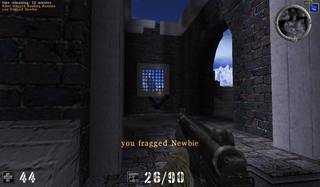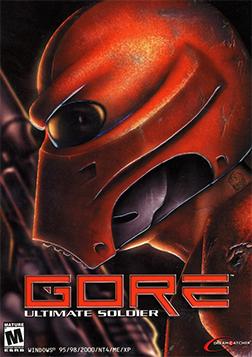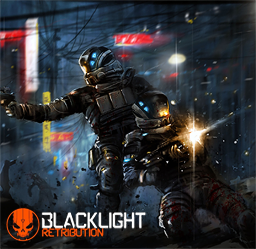
Deathmatch, also known as free-for-all, is a gameplay mode integrated into many shooter games, including first-person shooter (FPS), and real-time strategy (RTS) video games, where the goal is to kill the other players' characters as many times as possible. The deathmatch may end on a frag limit or a time limit, and the winner is the player that accumulated the greatest number of frags.

Battlefield 1942 is a 2002 first-person shooter video game developed by Digital Illusions CE and published by Electronic Arts for Microsoft Windows and Mac OS X. The game can be played in single-player mode against the video game AI or in multiplayer mode against players on the Internet or in a local area network. It is a popular platform for mod developers, with many released modifications that alter the gameplay and theme.

Wolfenstein: Enemy Territory is a free and open-source multiplayer first-person shooter video game within the Wolfenstein series. It was originally planned to be released as a commercial expansion pack to Return to Castle Wolfenstein and later as a standalone game. However, due to problems with the single-player aspect, the multiplayer portion was released on 29 May 2003 as a freeware standalone game. In January 2004, the source code for the game logic was released to the benefit of its modding community.

Tribes: Vengeance is a science fiction first-person shooter video game developed by Irrational Games and released by Vivendi Universal Games in October 2004. It was built on an enhanced version of the Unreal Engine 2.5, which Irrational Games called the Vengeance engine. Part of the Tribes series, in addition to its multiplayer network maps, Vengeance includes a complete single-player campaign.
Firearms is a first-person shooter mod for Half-Life which originated from a Quake modification. Initially developed in 1998, Firearms was created as a quasi-realistic team-based FPS. The mod's main feature is the large amount of usable weapons in the game.

Battlefield 2 is a first-person shooter video game developed by Digital Illusions CE and published by Electronic Arts for Microsoft Windows. It was released in June 2005 as the third game in the Battlefield franchise.
In video games, spawning is the live creation of a character, item or NPC. Respawning is the recreation of an entity after its death or destruction, perhaps after losing one of its lives. Despawning is the deletion of an entity from the game world.
A griefer or bad-faith player is a player in a multiplayer video game who deliberately and intentionally irritates, annoys or trolls other players within the game. Griefing is often accomplished by destroying things constructed by other players or stealing items. A griefer derives pleasure from the act of annoying other users, and as such, is a nuisance in online gaming communities.
GoldenEye: Source is a total conversion mod developed using Valve's Source engine. GoldenEye: Source is a multiplayer remake of the 1997 Nintendo 64 video game GoldenEye 007, itself based on the James Bond film GoldenEye. The mod's development began in 2005, and remains in active development as of 2024.

Fired Up is a vehicular combat game available on the PlayStation Portable. The game features a single-player campaign and a multiplayer mode which supports up to eight players. The game features demos of Wipeout Pure and MediEvil: Resurrection. Fired Up also features game sharing and downloadable content. It is derived from the 2002 PlayStation 2 online game Hardware: Online Arena.

Gore: Ultimate Soldier, also known as simply Gore, is a first-person shooter video game for Microsoft Windows, released on June 5, 2002. It was published by DreamCatcher Interactive and developed by 4D Rulers.

Metal Gear Online, and also known as Metal Gear Online 2, was a stealth third-person shooter video game for the PlayStation 3. It was an online multiplayer spin-off of the Metal Gear video game series. The starter pack of Online was available worldwide bundled with Metal Gear Solid 4: Guns of the Patriots, with a standalone release for Japan. The name Metal Gear Online is common with earlier online components for Metal Gear Solid 3: Subsistence and Metal Gear Solid: Portable Ops. Metal Gear Online's North American and European servers were shut down on June 12, 2012.

Red Orchestra 2: Heroes of Stalingrad and Rising Storm GOTY, now known as Rising Storm/Red Orchestra 2 GOTY on Steam, is a tactical multiplayer first-person shooter video game set during World War II, developed and published by Tripwire Interactive. It is a sequel to Red Orchestra: Ostfront 41-45. The title focuses heavily on the Battle of Stalingrad and the Pacific Theater. The game was released in September 2011. The game is currently a Windows exclusive and contains many new features compared to the original, including a new first-person cover system, which can also be combined with blind firing, first person collision detection, Commander role and abilities as well as an entirely new system of statistics tracking and player levelling. Maps are much bigger and had immediate 64-player support.
Left 4 Dead is a series of cooperative first-person shooter survival horror video games published by Valve. Set in the days after a pandemic outbreak of a viral strain transforming people into zombie-like feral creatures, the games follow the adventures of four survivors attempting to reach safe houses and military rescue while fending off the attacking hordes.
Multiplayer online battle arena (MOBA) is a subgenre of strategy video games in which two teams of players compete against each other on a predefined battlefield. Each player controls a single character with a set of distinctive abilities that improve over the course of a game and which contribute to the team's overall strategy. The typical objective is for each team to destroy their opponents' main structure, located at the opposite corner of the battlefield. In some MOBA games, the objective can be defeating every player on the enemy team. Players are assisted by computer-controlled units that periodically spawn in groups and march forward along set paths toward their enemy's base, which is heavily guarded by defensive structures. This type of multiplayer online video games originated as a subgenre of real-time strategy, though MOBA players usually do not construct buildings or units. Moreover, there are examples of MOBA games that are not considered real-time strategy games, such as Smite (2014), and Paragon. The genre is seen as a fusion of real-time strategy, role-playing and action games.

Blacklight: Retribution is a free-to-play first-person shooter video game developed and published by Hardsuit Labs for Microsoft Windows and PlayStation 4. It was initially published by Perfect World Entertainment on April 3, 2012, with a full Steam release on July 3. A PS4 version was released as a launch title in North America on November 15, 2013, followed by Europe and Australia on December 4.
Since the origin of video games in the early 1970s, the video game industry, the players, and surrounding culture have spawned a wide range of technical and slang terms.

TagPro is a free-to-play online multiplayer capture the flag video game originally designed and programmed by Nick Riggs. The first version was released in February 2013, after Riggs began experimenting with software platform Node.js. The game is named after one of its three obtainable power-ups. It follows the basic rules of capture the flag, along with some modifications, including power-ups, spikes, and other map elements.

Titanfall 2 is a first-person shooter video game, developed by Respawn Entertainment and published by Electronic Arts. A sequel to 2014's Titanfall, the game was released worldwide on October 28, 2016, for PlayStation 4, Windows, and Xbox One. In Titanfall 2, the player controls a titan, mecha-style exoskeletons and their pilots, who are agile and equipped with a variety of skills ranging from wall-running to cloaking. Set in a science fiction universe, the single-player campaign follows the story of Jack Cooper, a rifleman from the Frontier Militia, who bonds with his mentor's Titan BT-7274 after his mentor, Tai Lastimosa, is killed in action. Together, they embark on a quest to stop the Interstellar Manufacturing Corporation (IMC) from using a superweapon to destroy the Militia base on the planet Harmony.

Battlefield 1 is a first-person shooter game developed by DICE and published by Electronic Arts. It is the tenth installment in the Battlefield series and the first main entry in the series since Battlefield 4 in 2013. It was released for PlayStation 4, Windows, and Xbox One in October 2016.












